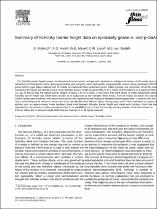JavaScript is disabled for your browser. Some features of this site may not work without it.
- ResearchSpace
- →
- Research Publications/Outputs
- →
- Journal Articles
- →
- View Item
| dc.contributor.author |
Myburg, G

|
|
| dc.contributor.author |
Auret, FD

|
|
| dc.contributor.author |
Meyer, WE

|
|
| dc.contributor.author |
Louw, CW

|
|
| dc.contributor.author |
Van Staden, MJ

|
|
| dc.date.accessioned | 2007-06-12T07:35:00Z | |
| dc.date.available | 2007-06-12T07:35:00Z | |
| dc.date.issued | 1998-07-18 | |
| dc.identifier.citation | Myburg, G, et al. 1998. Summary of Schottky barrier height data on epitaxially grown n-and p-GaAs. Thin sold films, vol 325, 2 January, pp 181-186 | en |
| dc.identifier.issn | 0040-6090 | |
| dc.identifier.uri | http://hdl.handle.net/10204/548 | |
| dc.description | Copyright:1998 Elsevier Science SA | en |
| dc.description.abstract | The Schottky barrier height values, as determined by the current–voltage and capacitance–voltage techniques, of 43 metals which were fabricated by following the same cleaning procedure and using the same high-quality organ metallic vapour phase epitaxially (OMVPE) grown (100) n-type GaAs material and 13 metals on molecular beam epitaxially grown (MBE) p-GaAs, are presented. Of all the metals involved in this study, Ga had the lowest mean Schottky barrier height of about 0.60 eV on n-GaAs and the highest on p-GaAs of 0.83 eV. Cu, Ag, Pt and Sb had the highest barrier heights of about 1 eV on n-GaAs. It was found that there exists no linear relationship between Schottky barrier height and metal work function as is suggested by the Schottky–Mott theory, if all 43 metals are taken into account. Similar results were obtained if the metal work function was replaced by the Pauling or Miedema electro negativities. In contrast with this, if only a selected group of metals is chosen and more specifically those with the higher melting points which were deposited by means of an electron gun, an approximately linear tendency does exist between Schottky barrier height and metal work function. From this linear dependency, the density of states was determined to be about 6 x 10(13)/eV per cm2 and the average pinning position of the Fermi level as 0.55 eV below the conduction band. | en |
| dc.language.iso | en | en |
| dc.publisher | Elsevier Science SA | en |
| dc.subject | Electrical properties | en |
| dc.subject | Electrical measurements | en |
| dc.subject | Metallizations | en |
| dc.subject | Schottky barriers | en |
| dc.title | Summary of Schottky barrier height data on epitaxially grown n-and p-GaAs | en |
| dc.type | Article | en |
| dc.identifier.apacitation | Myburg, G., Auret, F., Meyer, W., Louw, C., & Van Staden, M. (1998). Summary of Schottky barrier height data on epitaxially grown n-and p-GaAs. http://hdl.handle.net/10204/548 | en_ZA |
| dc.identifier.chicagocitation | Myburg, G, FD Auret, WE Meyer, CW Louw, and MJ Van Staden "Summary of Schottky barrier height data on epitaxially grown n-and p-GaAs." (1998) http://hdl.handle.net/10204/548 | en_ZA |
| dc.identifier.vancouvercitation | Myburg G, Auret F, Meyer W, Louw C, Van Staden M. Summary of Schottky barrier height data on epitaxially grown n-and p-GaAs. 1998; http://hdl.handle.net/10204/548. | en_ZA |
| dc.identifier.ris | TY - Article AU - Myburg, G AU - Auret, FD AU - Meyer, WE AU - Louw, CW AU - Van Staden, MJ AB - The Schottky barrier height values, as determined by the current–voltage and capacitance–voltage techniques, of 43 metals which were fabricated by following the same cleaning procedure and using the same high-quality organ metallic vapour phase epitaxially (OMVPE) grown (100) n-type GaAs material and 13 metals on molecular beam epitaxially grown (MBE) p-GaAs, are presented. Of all the metals involved in this study, Ga had the lowest mean Schottky barrier height of about 0.60 eV on n-GaAs and the highest on p-GaAs of 0.83 eV. Cu, Ag, Pt and Sb had the highest barrier heights of about 1 eV on n-GaAs. It was found that there exists no linear relationship between Schottky barrier height and metal work function as is suggested by the Schottky–Mott theory, if all 43 metals are taken into account. Similar results were obtained if the metal work function was replaced by the Pauling or Miedema electro negativities. In contrast with this, if only a selected group of metals is chosen and more specifically those with the higher melting points which were deposited by means of an electron gun, an approximately linear tendency does exist between Schottky barrier height and metal work function. From this linear dependency, the density of states was determined to be about 6 x 10(13)/eV per cm2 and the average pinning position of the Fermi level as 0.55 eV below the conduction band. DA - 1998-07-18 DB - ResearchSpace DP - CSIR KW - Electrical properties KW - Electrical measurements KW - Metallizations KW - Schottky barriers LK - https://researchspace.csir.co.za PY - 1998 SM - 0040-6090 T1 - Summary of Schottky barrier height data on epitaxially grown n-and p-GaAs TI - Summary of Schottky barrier height data on epitaxially grown n-and p-GaAs UR - http://hdl.handle.net/10204/548 ER - | en_ZA |






